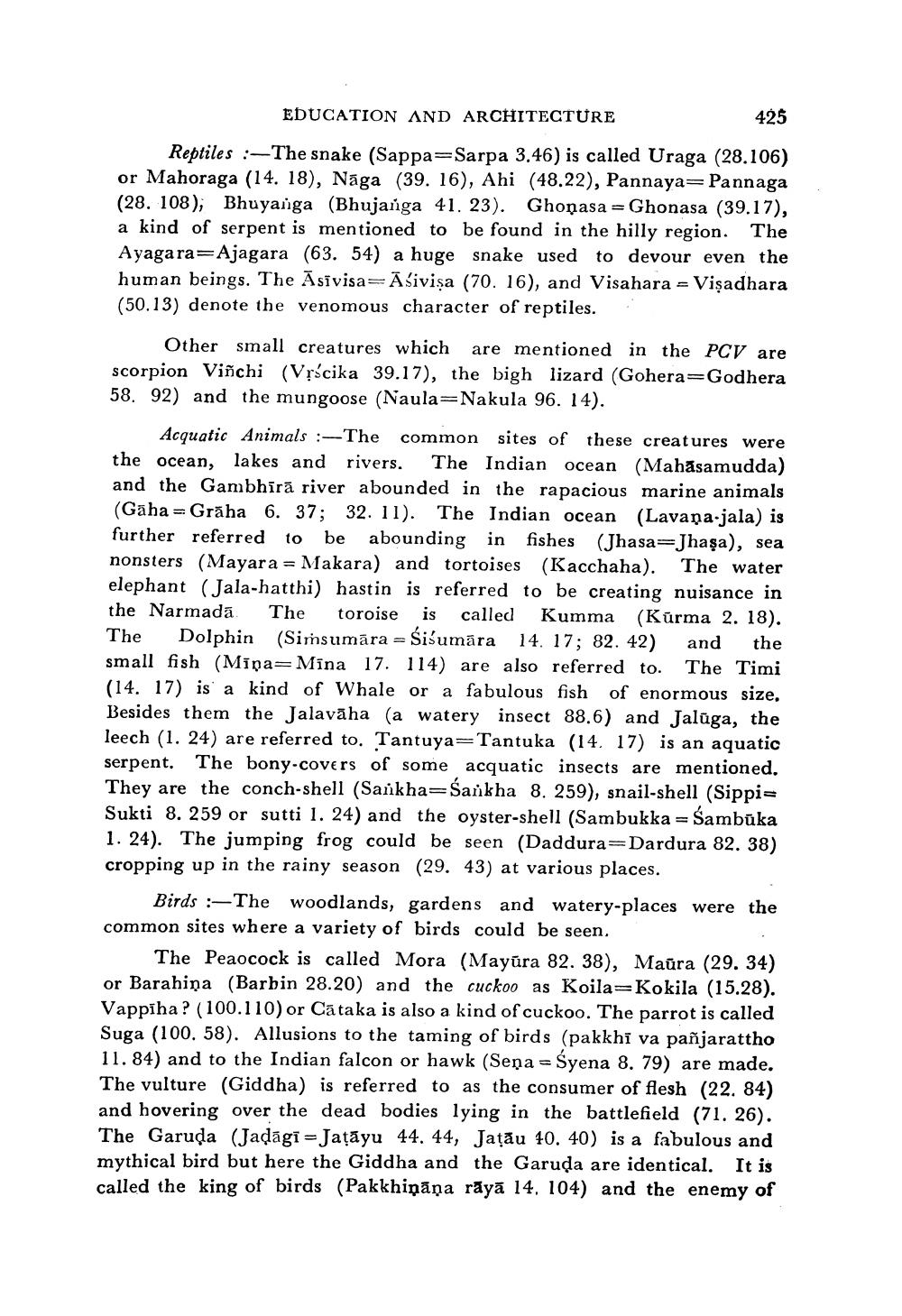________________
425
ава
EDUCATION AND ARCHITECTURE Reptiles :--The snake (Sappa=Sarpa 3.46) is called Uraga (28.106) or Mahoraga (14. 18), Naga (39. 16), Ahi (48.22), Pannaya=Pannaga (28. 108), Bhuyanga (Bhujanga 41. 23). Ghoặasa = Ghonasa (39.17), a kind of serpent is mentioned to be found in the hilly region. The Ayagara=Ajagara (63. 54) a huge snake used to devour even the human beings. The Āsivisa=Āśivisa (70. 16), and Visahara = Vişadhara (50.13) denote the venomous character of reptiles.
Other small creatures which are mentioned in the PCV are scorpion Viñchi (Vrścika 39.17), the bigh lizard (Gohera=Godhera 58. 92) and the mungoose (Naula=Nakula 96. 14).
Acquatic Animals :-The common sites of these creatures were the ocean, lakes and rivers. The Indian ocean (Mahasamudda) and the Gambhīrā river abounded in the rapacious marine animals (Gäha = Grāha 6. 37; 32. 11). The Indian ocean (Lavaņa.jala) is further referred to be abounding in fishes (Jhasa=Jhaşa), sea nonsters (Mayara = Makara) and tortoises (Kacchaha). The water elephant (Jala-hatthi) hastin is referred to be creating nuisance in the Narmadā. The toroise is called Kumma (Kūrma 2. 18). The Dolphin (Simsumāra = śiśumāra 14. 17; 82. 42) and the small fish (Mīpa=Mina 17. 114) are also referred to. The Timi (14. 17) is a kind of Whale or a fabulous fish of enormous size, Besides them the Jalavāha (a watery insect 88.6) and Jalūga, the leech (1. 24) are referred to. Tantuya=Tantuka (14. 17) is an aquatic serpent. The bony-covers of some acquatic insects are mentioned. They are the conch-shell (Saikha=Sarkha 8. 259), snail-shell (Sippi= Sukti 8. 259 or sutti 1. 24) and the oyster-shell (Sambukka = Sambūka 1. 24). The jumping frog could be seen (Daddura=Dardura 82. 38) cropping up in the rainy season (29. 43) at various places.
Birds : The woodlands, gardens and watery-places were the common sites where a variety of birds could be seen.
The Peaocock is called Mora (Mayūra 82. 38), Maūra (29. 34) or Barahiņa (Barbin 28.20) and the cuckoo as Koila=Kokila (15.28). Vappiha? (100.110) or Cā taka is also a kind of cuckoo. The parrot is called Suga (100. 58). Allusions to the taming of birds (pakkhi va pañjarattho 11. 84) and to the Indian falcon or hawk (Seņa = Syena 8. 79) are made. The vulture (Giddha) is referred to as the consumer of flesh (22. 84) and hovering over the dead bodies lying in the battlefield (71. 26). The Garuda (Jadagi = Jațāyu 44. 44, Jațău 10. 40) is a fabulous and mythical bird but here the Giddha and the Garuda are identical. It is called the king of birds (Pakkhiņāņa rāyā 14, 104) and the enemy of




